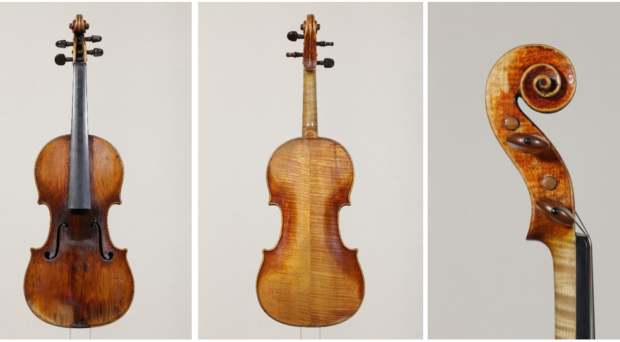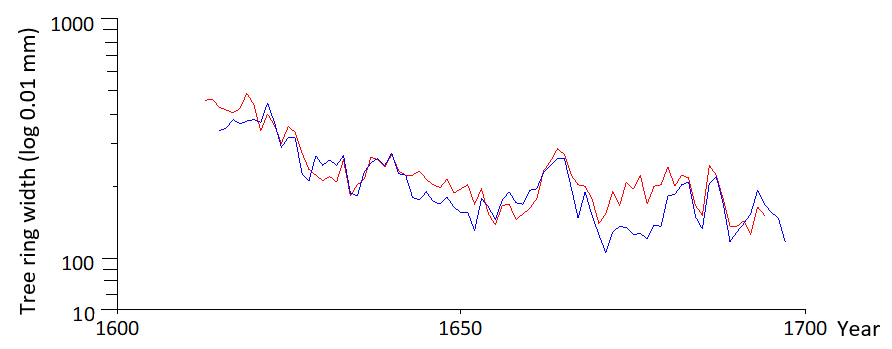
An unknown Guarneri violin lay undisturbed in its unsuspecting owner’s attic. Various attempts at dating the violin and attributing it to a violin-maker, mostly on the basis of its technical and stylistic characteristics, had always been unsuccessful in the past.
It is customary for violins to bear a label on the inside, giving the violin-maker’s name, the place where it was made and, sometimes, further information.
However, the authenticity of labels is often questionable and, in general, it is not recommended to rely on a musical instrument’s label for its date or attribution.
Although the label of this violin read “Joseph Guarnerius Filuis Andreae Cremonae Sub Titulo S. Theresie, 1705”, that is, Giuseppe Guarneri, son of Andrea, in the name of St. Therese (made it) in the year 1705 (or 6?), this label was not be relied on.
It was clearly not original, as it had been written in a typeface that did not exist at the time and, in addition, it contained a spelling error: Filuis instead of Filius.
Some photographs of the instrument were sent via WhatsApp to me. A dendrochronological analysis was carried out directly on the WhatsApp photos and the violin was found to be a real Guarneri!
Dendrochronology is a method that dates wooden artifacts by measuring the width of annual growth rings visible in the wood. In suitable tree species, the size of these annual rings reflects climatic conditions, producing large rings in a favorable years and small rings in negative ones.
These ring measurements of, say, 100 years form a graph that occurs only once in time because—giving a simplified explanation—the weather (i.e., the summer temperatures) over a particular 100-year period will never be exactly the same again in another century.
Dendrochronology has its ideal application in the field of musical instruments, where it can be applied in a completely non-invasive way, not damaging the artifact in any way.
In addition, dendrochronology also helps to identify the wood’s provenance and supplies information on how the soundboard was made, giving details of ring width and regularity.
At first, the violin was precisely dated: the last ring on the soundboard is the year 1696, which corresponds to the golden age of classical Cremonese violin-making.
This provoked curiosity and naturally led to investigations with regard to its maker.
In order to prove the suspected attribution to Guarneri, the violin’s dendrochronological time-series (see graph) had to be compared with that of a violin definitely made by Giuseppe Guarneri.

But where might one find the dendrochronological time-series of another violin that had definitely been made by Giuseppe Guarneri?
An initial search was made on the Internet. After sifting through countless pieces of information of all kinds that were nearly always misleading, a dendrochronological report from a prestigious French auction house was found.
The report precisely deals with the dendrochronological analysis of a violin made by Giuseppe Guarneri! Unfortunately, the instrument’s dendrochronological data were not mentioned in the paper but there was a photograph of the violin on the cover.
The time series previously taken from the WhatsApp photo was compared against a fresh time-series taken from the cover of the report.
After some initial incredulity, considering that the trends of tree-ring series of the wood of both violins is almost perfectly superimposable, it became clear that the two violins must have been made using wood from the same tree, indicating the real possibility of a second violin by the same maker.
A technical and stylistic examination carried out by an expert confirmed the attribution and dispelled any doubt: in fact, the two violins had both been made by Giuseppe Guarneri as “twin” violins. They are identical in all parts: all their construction characteristics are the same and the wood came from the same tree trunk.
Before this study, both the violin’s date and its attribution were unknown.
The dendrochronological analysis of a WhatsApp photo placed this musical instrument into a particular historical period, the golden age of classical violins, and gave rise to hypotheses regarding the timber’s provenance (Paneveggio, Fiemme Valley, Italy), as well as attributing it to one of the greatest violin-makers, Giuseppe Guarneri.
This study demonstrates the strength of dendrochronology, a scientific dating method capable of transforming an old violin forgotten in the attic into a museum piece, worth more than two million euros.
Comments